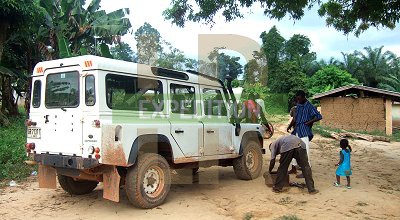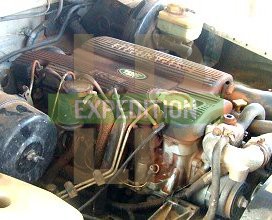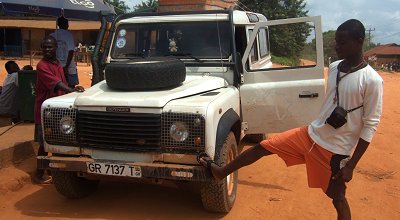110 SW 300Tdi ROW LHD
To the untrained eye this title looks like a lot of acronyms, but to others it means so much more. There is a good argument to say that the 300Tdi engined Rest of the World (ROW) spec Left Hand drive 110 Defender Station Wagon is the most desirable Land Rover Defender to make into an expedition vehicle.
Having owned a 200Tdi Hardtop for a year, I reviewed its suitability for an expedition in the future. I felt that whilst a Hardtop holds the ability to hold a lot of equipment, I find only being able to carry two passengers a hindrance in the UK. I did eventually replace it with a 300Tdi Station Wagon
In 2009 whilst thinking about replacing the Hardtop, I went along to Foley Overland to have a look at a few Defender Station Wagons. I was taken aback the scope of transformation that the Defenders undergo from entering to leaving fully prepped. Chatting with one of the Foley brothers (Paul) he showed me the level of workmanship and preparation required to transform the vehicles into something of their standard. The vehicles seemed a bit too prepped for me, having fresh water plumbing with a pump/filter/tank, air con, storage drawers and expensive roof tent, but brilliant if you want a home away from home on expedition.
 Eventually we got to the brand new 2006 300Tdi ROW 110 SW that was being prepared for registration as an 09 vehicle. It was a maginificent example, having mere hundreds of miles on the clock. It was truly astounding and something which demands a premium - near enough to £30,000.
Eventually we got to the brand new 2006 300Tdi ROW 110 SW that was being prepared for registration as an 09 vehicle. It was a maginificent example, having mere hundreds of miles on the clock. It was truly astounding and something which demands a premium - near enough to £30,000.
The "Rest of the World" acronym pertains to a variety of the Defender designed for export outside of the Western world. The 300Tdi was replaced in 1998 by the Td5 due to EU emissions, but the 300Tdi was continued to be produced for the export market. It was produced up until 2006 when all vehicles were changed to the "Puma" engine, whereby a lot were left surplus in the UK.
This vehicle, he told me, was one of only 20 unused 2006 ROW 300Tdis left in existence. You see adverts for them every now and then, but it appears that the last chances of owning a virtually brand new ultimate expedition vehicle has since disappeared. The last "delivery miles" ROW spec Defender I saw was in late 2012; waiting to be sent overseas. Land Rover Owner magazine ran a buyers guide feature on one in December 2009 priced at £21,269 from Nene Overland, but even they and Foley cannot not find them these days.
The perfect specification
Of course there are personal preferences to what makes the ultimate expedition vehicle. In my opinion, it is a 2004 110 Station Wagon 300Tdi ROW LHD.
The LHD preference to me is simple maths seeing that 72% of the world drives on the right, so LHD would be pretty handy for an expedition vehicle...!

The 300Tdi is regarded as a very good engine for an expedition Land Rover due to its lack of electronics and easy self-maintenance. The ROW version doesn't have an EGR which means it can extract more power at the expense of emissions. But what is wrong with a 94-98 300Tdi? Well apart from the fact that a ROW Defender would be newer, nothing per se. However things changed since 1998 to make the Land Rover Defender a more refined product.
In 1999 vehicles were added with a more robust and quieter LT230Q Transfer box and later spec revision of the R380 gearbox.
In 2002, the dashboard, speedo and gauges became clearer, the speedo more accurate and easier to read at night. The rear door was re-designed to be stronger and more durable. The brake calipers were improved and the panhard rod strengthened. The wiring was given a redesign with more weather proof connectors.
Later in the 2002 model year, the Salisbury axle was replaced by the short now Rover diff as used in the P38 and Wolf, albeit without the strengthened axle case. To me, this is a small sticking point. The Rover diff is more easily repairable in the field, whereas the Salisbury diff is more durable for the kind of loads an expedition vehicle will carry. In the end I have converted my Salisbury axle to the later style.
The verdict
I am somewhat biased to the Rest of the World spec because the first Land Rover Defender I ever drove was a 2002 LHD 300Tdi ROW 110 Hardtop in Belize. I drove a 1997 Hardtop at the same time and to me the earlier models were a bit more rough around the edges. But I didn't think much of it. Then I went to Ghana and drove a 2003 LHD 300Tdi ROW 110 Station Wagon.
 These Rest of the World spec vehicles were the newest in the fleet and so had relatively high mileage for their age from being ragged around off road tracks. It was only return to the UK and through more understanding that I realised that ROW Land Rovers are hard to come by. I had been lucky enough to have used two within the first 18 months of my Land Rover driving life!
These Rest of the World spec vehicles were the newest in the fleet and so had relatively high mileage for their age from being ragged around off road tracks. It was only return to the UK and through more understanding that I realised that ROW Land Rovers are hard to come by. I had been lucky enough to have used two within the first 18 months of my Land Rover driving life!
The vehicles had only been modified to add snorkels and internal/external roll cages. To me, this was all that was needed to make them great expedition vehicles. Whilst the vehicles coming from Foley Overland are exceptionally catered for, I'm used to a more practical approach with carrying fewer items. A jerry can of water would suffice over elaborate plumbing throughout the rear of the vehicle. But maybe that's youth talking. Even unmodified, a ROW 300Tdi would still cost a bomb.
I would jump on one of these vehicles at the right price. To me, they are the ultimate expedition vehicle.
